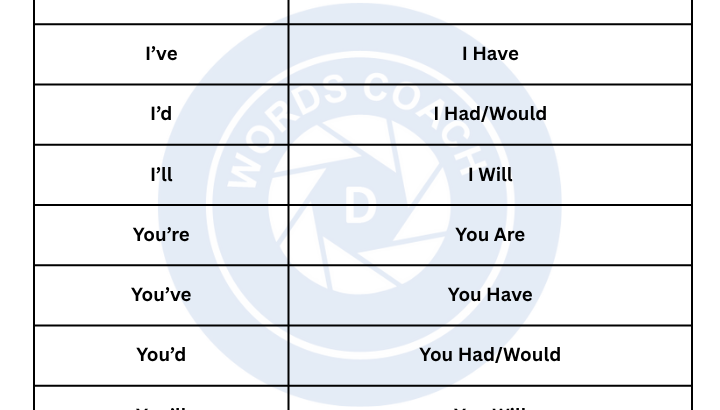The Basic English Grammar Quiz is designed to test your understanding of the fundamental rules of English. It covers essential topics such as nouns, pronouns, verbs, tenses, articles, adjectives, adverbs, prepositions, and sentence structure. This quiz helps learners practice simple grammar rules, avoid common mistakes, and build a strong foundation for speaking and writing English confidently.
Category: English Grammar
English Grammar: Learn English grammar in a quick and effective manner by following the tips given in this article. English Grammar is the way we arrange words to make proper sentences. Word-level grammar covers verbs and tenses, nouns, adverbs etc.
English Proficiency Test
English Proficiency Test Here’s a 30-question fill-in-the-blank exercise for an English Proficiency Test. Answer: Download Word Coach Application

Contractions In English
Learn all about contractions in English with a complete list, definitions, and example sentences. Improve your fluency and sound more natural in everyday conversations using English contractions.
Action Verbs Quiz/Exercise
Action Verbs Quiz/Exercise. Test your knowledge of Action Verbs with this fun quiz!
English Grammar Level Test (A1–C1)
Take this English Grammar Level Test (A1–C1) to assess your grammar skills. Covering all levels from beginner (A1) to advanced (C1), this test includes 20 questions with explanations to help you improve. Perfect for students, teachers, and English learners!
English Grammar Exercises and Quizzes
Lots of English grammar exercises and quizzes to help you practise your English.

Adverbs of Time Exercise
Boost your English grammar skills with our comprehensive Adverbs of Time Exercise. Practice with examples and answers to master adverbs like “now,” “soon,” and “yesterday.” Perfect for learners of all levels!

Phrases and Clauses Exercises
Enhance your grammar skills with our comprehensive Phrases and Clauses Exercises. Learn the differences, explore examples, and practice with engaging quizzes to improve your writing and communication.

Suffixes Exercise
Improve your grammar and vocabulary with our suffixes exercise! Learn how suffixes change word meanings and practice forming new words with engaging activities.

What Are English Proverbs? Definition and Examples
What Are English Proverbs? Definition and Examples

Short Vowel Words | Short Vowel Sounds Definition, Differences & Examples
Short Vowel Words | Short Vowel Sounds Definition, Differences & Examples

Direct and Indirect Objects in English Grammar | Definitions, Examples, and Tips
Learn about direct and indirect objects in English grammar with clear definitions, examples, and useful tips. Understand how to identify objects in sentences to improve your grammar skills.

Difference Between Auxiliary and Main Verbs
Understand the key differences between auxiliary verbs and main verbs in English grammar. This detailed guide explains the roles, functions, and uses of both types of verbs, with clear examples to help you grasp their distinctions and improve your language skills.

Auxiliary Verbs: Types and Uses
Explore the essential role of auxiliary verbs in English grammar. Learn about different types of auxiliary verbs, their functions, and how to use them effectively in sentences. This comprehensive guide covers modal verbs, primary auxiliaries, and semi-modal verbs with clear examples and explanations.

Difference Between Grammar and Vocabulary
Explore the distinct roles of grammar and vocabulary in language learning. Understand how grammar structures sentences while vocabulary provides the words needed to communicate. This guide includes clear definitions, examples, and practical tips for mastering both aspects of language.

Difference Between Hear and Listen
Difference Between Hear and Listen. Understand the key differences between “hear” and “listen” with detailed explanations and examples. Learn how to use these terms correctly in various contexts to improve your English language skills.

Difference Between Was and Had
Understanding the difference between was and had in English grammar. Learn their uses, rules, and examples to improve your language skills.

Difference Between Like and As
Difference Between Like and As. Explore the key differences between “like” and “as” in English grammar. Learn how to use these terms correctly in comparisons, similes, and various contexts with detailed explanations and examples.

Question words
Discover the essential question words in English and their uses. Learn how to form effective questions using words like who, what, where, when, why, and how. Includes examples and tips for mastering interrogative sentences.

Differences Between Active and Passive Voice
Learn the distinctions between active and passive voice in English grammar. Understand their structures, uses, and effects on sentence clarity and emphasis. Includes detailed examples and practical tips for writing effectively.

Difference Between Noun and Pronoun
Difference Between Noun and Pronoun. Explore the key differences between nouns and pronouns, their functions in sentences, and how they contribute to the structure of language. Understand with examples the unique roles these parts of speech play in grammar.

Difference Between Some Time or Sometime
Ever wondered when to use “some time” versus “sometime”? This blog post clarifies the difference! Learn how to distinguish between indefinite periods and specific points in time, mastering the nuances of these two common phrases and becoming a confident English communicator.

Difference Between Regular and Irregular verbs
This resource explains the difference between regular and irregular verbs in English. Regular verbs follow a set pattern for conjugation in different tenses, while irregular verbs have unique forms that need to be memorized. Understanding this difference is essential for proper verb usage and clear communication in English.

Regular Verbs List
Regular Verbs List: This is a list of regular verbs in English, including their present, past, and future tense forms. Regular verbs are verbs that follow a predictable pattern for conjugation. This list can be a helpful resource for students learning English or for anyone who wants to improve their grammar skills.

Difference between Emigrate and Immigrate
Difference between Emigrate and Immigrate. To distinguish between emigrate and immigrate and use them correctly in context.
